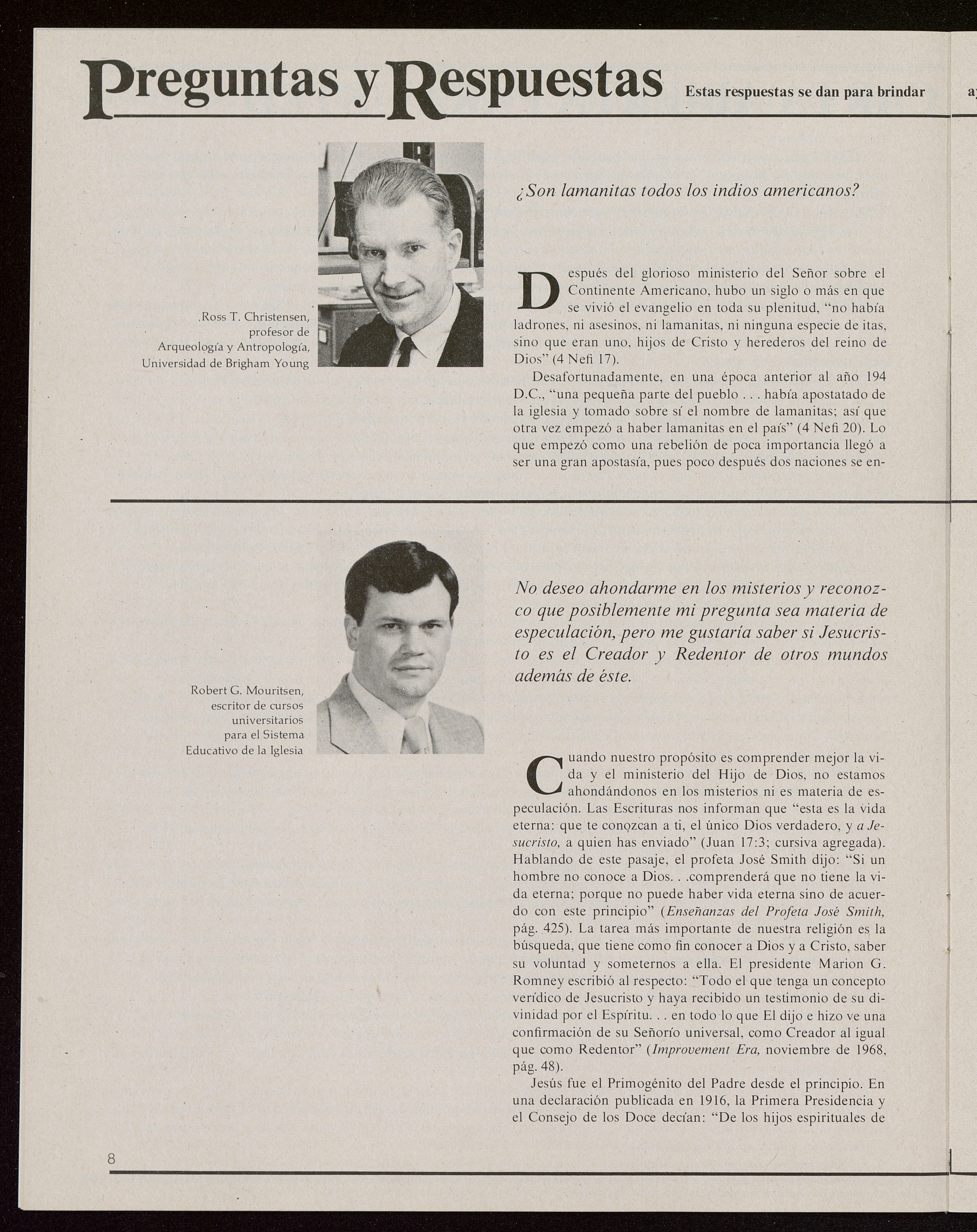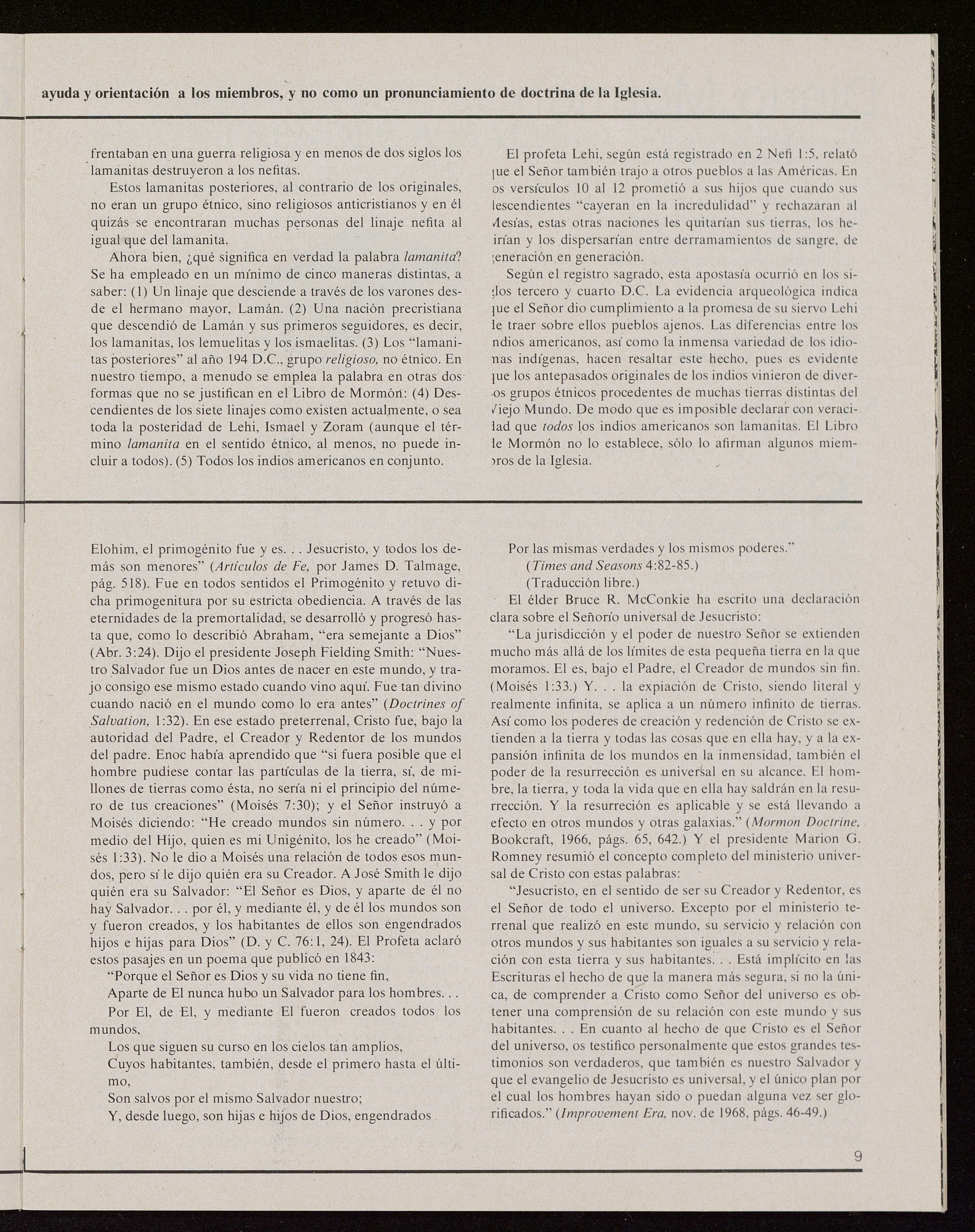Ross T. Christensen writes that not all modern Native Americans are necessarily ethnic Lamanites.
- Type
- Periodical
- Hearsay
- Direct
- Reference
Ross T. Christensen, "¿Son lamanitas todos los indios americanos?" Liahona 22, no. 11 (November 1976): 8–9
- Scribe/Publisher
- Liahona
- Audience
- Latter-day Saints
- Transcription
Después del glorioso ministerio del Señor sobre el Continente Americano, hubo un siglo o más en que se vivió el evangelio en toda su plenitude, “no había ladrones, ni asesinos, ni lamanitas, ni ninguna especie de itas, sino que eran uno, hijos de Cristo y herederos del reino de Dio” (4 Nefi 17).
Desafortunadamente, en una época enterior al año 194 D.C., “una pequeña parte del pueblo . . . había apostatado de la iglesia y tomado sobre sí el nombre de lamanitas; así que otra vez empezó a haber lamanitas en el país” (4 Nefi 20). Lo que empezó como una rebellion de poca importancia llegó a ser una gran apostasía, pues poco después dos naciones se en frentaban en una Guerra religiosa y en menos de dos siglos los lamanitas destruyeron a los nefitas.
Estos lamanitas posteriors, al contrario de los originales, no eran un grupo étnico, sino religiosos anticrstianos y en él quizás se encontraran muchas personas del linaje nefita al igual que del lamanita.
Ahora bien, ¿qué significa en verdad la palabra lamanita? Se ha empleado en un mínimo de cinco maneras distintas, a saber: (1) Un linaje que desciende a través de los varones desde el hermano mayor, Lamán. (2) Una nación precristiana que descendió de Lamán y sus primeros seguidores, es decir, los lamanitas, los lemuelitas y los ismaelitas. (3) Los “lamanitas posteriors” al año 194 D.C., grupo religioso, no étnico. En nuestro tiempo, a menudo se emplea la palabra en otras dos formas que no se justifican en el Libro de Mormón: (4) Descendientes de los siete linajes como existen actualmente, o sea toda la posteridad de Lehi, Ismael y Zoram (aunque el término lamanita en el sentido étnico, al menos, no peude incluir a todos.) (5) Todos los indios americanos en conjunto.
El profeta Lehi, según está registrado en 2 Nefi 1:5, relató que el Señor también trajos a otros pueblos a las Américas. En los versículos 10 al 12 prometió a sus hijos que cuando sus descendientes “cayeran en la incredulidad” y rechazaran al Mesías, estas otras naciones les quitarían sus tierras, los heirían y los dispersarían entre derramamientos de sangre, de generación en generación.
Según el registro Sagrado, esta apostasía ocurrió en los siglos tercero y cuarto D. C. La evidencia arqueológica indica que el Señor dio cumplimiento a la promesa de su siervo Lehi de traer sobre ellos pueblos ajenos. Las díferencias entra los indios americanos, así como la inmensa variedad de los idiomas indígenas, hacen resaltar este hecho, pues es evidente que los antepasados originales de los indios vinieron de divervos grupos étnicos procedentes de muchas tierras distintas del Viejo Mundo. De modo que es imposible declarer con veracidad que todos los indios americanos son lamanitas. Es Libro de Mormón no lo establece, solo lo afirman algunos miemoros de la Iglesia.
===
After the glorious ministry of the Lord on the American Continent, there was a century or more in which the gospel was lived in all its fullness, "there were no thieves, nor murderers, nor Lamanites, nor any kind of -ites, but they were one, sons of Christ, and heirs of the kingdom of God” (4 Nephi 17).
Unfortunately, at a time before A.D. 194, “a small part of the people . . . he had apostatized from the church and taken upon himself the name of Lamanites; so that again there began to be Lamanites in the country” (4 Nephi 20). What began as a minor rebellion became a major apostasy, for shortly thereafter two nations were engaged in a religious war, and in less than two centuries the Lamanites destroyed the Nephites.
These later Lamanites, unlike the original ones, were not an ethnic group, but rather an anti-Christian religious group, and may have included many people of Nephite as well as Lamanite lineage.
Now, what does the word Lamanite really mean? It has been used in at least five different ways, namely: (1) A lineage descending through the males from the eldest brother, Laman. (2) A pre-Christian nation that descended from Laman and the first followers of him, that is, the Lamanites, the Lemuelites, and the Ishmaelites. (3) The "Lamanites after" A.D. 194, a religious, non-ethnic group. In our time, the word is often used in two other ways that are not justified in the Book of Mormon: (4) Descendants of the seven lineages as they exist today, that is, all the posterity of Lehi, Ishmael, and Zoram (although the The term Lamanite in the ethnic sense, at least, cannot include all.) (5) All American Indians together.
The prophet Lehi, as recorded in 2 Nephi 1:5, related that the Lord also brought other peoples to the Americas. In verses 10-12 he promised his sons that when their descendants “fall into unbelief” and reject the Messiah, these other nations would take their lands, wound them, and scatter them amidst bloodshed, from generation to generation.
According to the sacred record, this apostasy occurred in the third and fourth centuries A.D. Archaeological evidence indicates that the Lord fulfilled the promise of his servant Lehi to bring upon them alien peoples. The differences between the American Indians, as well as the immense variety of indigenous languages, highlight this fact, since it is evident that the original ancestors of the Indians came from diverse ethnic groups from many different lands of the Old World. So it is impossible to truthfully state that all American Indians are Lamanites. The Book of Mormon does not establish it, only some members of the Church affirm it.
- Source Link
- https://catalog.churchofjesuschrist.org/assets/278c8b6d-797e-4219-b7a9-8f2e447504b9/0/9?lang=eng
- Citations in Mormonr Qnas
The B. H. Roberts Foundation is not owned by, operated by, or affiliated with the Church of Jesus Christ of Latter-day Saints.


